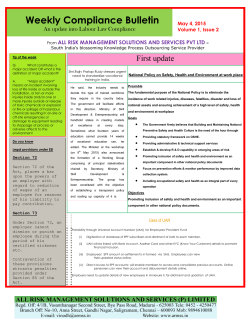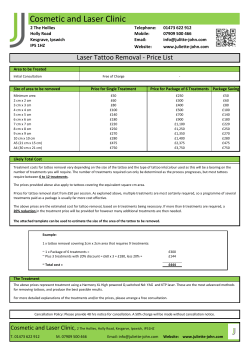
- The Fluid Journal Online
What About Late Season Application of Foliar N? Post flag leaf has been too variable to draw conclusions. Drs. Brian Arnall, Brad Seaborn, Jeremiah Mullock, and Mr. Brandon Burgess The Fluid Journal • Official Journal of the Fluid Fertilizer Foundation • Spring 2015 • Vol. 23, No. 2, Issue #88 ▼ DOWNLOAD Summary: In our studies across the six site years, late-season foliar nitrogen (N) never impacted yield in either a positive or negative manner when compared to the standard fertility treatment. The response to overall measured variables, which included protein, mix tolerance, and loaf volume, was very variable and not consistent. Oklahoma’s post-flag leaf environment may be too variable to say, conclusively, that late-season foliar application would improve the baking and milling qualities of hard red winter wheat. I n the fall of 2010 the Kansas Board of Trade proposed and passed quality standards on No. 2 Hard Red Winter Wheat, in which any wheat that fell below 10.5 percent would be considered undeliverable. This new standard significantly increased the interest of lateseason N applications to increase grain protein in the Southern Great Plains. It has been a practice widely used and accepted in the Northwest and Eastern US, relative to spring wheat production. However, in the Southern Great Plains, late-season N applications are not widely used. Average yield levels of the region often do not support additional trips over the field. In a 2002 field study by Woolfolk, et al., it was reported that when UAN and ammonium sulfate were applied to winter wheat pre- and post-flowering, grain N concentration was increased. However, producers in the region are commonly making fungicide applications during flag leaf stage. This presents an opportunity to apply fertilizer N with no additional application cost. To this point, many producers are putting one to two gallons of low salt N products in with the flag leaf fungicide application in hopes of either improved yield or increased grain protein levels. Trial specifics Evaluation. This trial was established to evaluate the use of two N sources applied 11 flag leaf (FL) and post anthesis (PA) to improve Great Plains hard red winter wheat grain yield, protein, and milling and baking characteristics. Sources. The two sources evaluated were UAN 28-0-0 and CoRoN 25-00. CoRoN (which is labeled as being derived from urea, methylene diurea, and methylene urea) was selected due to its low salt level and wide availability within the region. Rates. Protein levels were maximized at a rate of 34 kg N ha-1 (Woolfolk et al., 2000). However, the greatest majority of the low salt N fertilizers is not being recommended at a rate above 18 L ha-1 or as, in the case of CoRoN, 7.6 hg N ha-1. Therefore, it was important to evaluate rates below that which Woolfolk looked at. Both N sources were applied at three rates (6.7, 13.4, and 26.8 kg N ha-1) at the two timings FL and PA. Applications were made using a CO2 pressurized backpack sprayer. All treatments were supplied at a flow rate of 93.8 L ha-1 with water as the carrier. Typically, FL applications occurred in mid-April while PA applications were made in mid to late May. The constant flow rate was chosen to ensure uniform application of the fertilizer. All treatments, excluding the non-fertilized check, received 45 kg N ha-1 pre-plant and 45 kg N ha-1 at topdress. Unlike the Woolfolk work, where treatments were applied in the cool of the The Fluid Journal morning to reduce the likelihood of tissue burn, the treatments for this study were all applied mid-day. However, the use of water as a carrier likely reduced tissue burn, at least for the lower N rates. Location. The trials were established at two locations: Lahoma and Lake Carl Blackwell (LCB). Figures 1, 2, and 3 document the deviation in plant-available water, average daily temperature, and relative humidity from the long-term average values for each year of the study at the Lahoma site. Treatments. Our study consisted of 14 treatments, which included a non-fertilized and a fertilized control arranged in a RCBD. Plot size measured 3m by 6m. Harvest. At maturity, the grain was harvested from the center 1.5 m of each plot with a Massey 8XP combine. Evaluation. All grain from each plot was retained and sent to the USDA ARS Baking and Milling lab in Manhattan KS for evaluation of milling and baking qualities. Samples. It should be noted that all samples from the 2013 harvest were lost when packaging was damaged during the shipping process. Therefore, for the 2013 crop year, only yield data are available. Baking, milling variables Recommended Quality Targets (RQT) are set by the HWW Quality Target Spring 2015 Committee. The purpose of RQT for Hard Red Winter Wheat (HRWW) is to provide specific quality goals for the breeding community, water producers, and marketing programs in order to assist and guide the decisions needed to maintain the consistency and end-use quality of the U.S. HRW market class. Variables are: • Test Weight > 60 lb/bu-1 • Protein > 12.0 • Mixing tolerance: ranked value with a score from 0-6; values above 3 are preferred • Mix time: 3 to 5 minutes • Loaf Volume > 850 cc Flour yield was also measured. The greater the percent yield the better. 2011 crop year The 2011 crop year was characterized by a late spring warm-up with good winter moisture but a dry spring with below average relative humidity levels during the FL and PA application window. Yields. At both locations the yield of the check was not significantly different from any other treatment documenting a nonresponsive crop season. Yields at Lahoma, however, were significantly higher than LCB with ranges of 4.0 to 5.4 Mg ha-1 and 1.7 to 2.2 Mg ha-1 respectively. Protein. While yield was not affected at either location, protein was increased above the non-fertilized control at LCB. There was no significance in protein at Lahoma across all 14 treatments and no significant differences in protein at LCB for any treatment that received fertilizer N. At Lahoma, the 13.4 kg N ha-1 PA application resulted in the highest protein content. Five of the six treatments with the highest protein content at LCB were PA applications. Baking/milling. Of the baking and milling qualities measured, only mixing tolerance was impacted by the late-season N applications at Lahoma, with all UAN treatments resulting in significantly higher values than CoRoN at 3.67 and 2.94, respectively. Loaf volume. At LBC, loaf volume was the only variable significantly impacted. All late-season N treatments resulted in a 55cc increase in loaf volume over the fertilizer control. Samples. All samples fell below the 850cc target. 2012 crop year The 2012 crop year was characterized by good soil moisture through winter and the onset of a severe drought in June. Early spring temperatures and relative humidity values were above average; however, May Spring 2015 Figure 1. The deviation from 2000 to 2014 average of plant available water (inches) in the top 16 inches of soil profile for the Lahoma Research Station in 2011, 2012, and 2013. Figure 2. The deviation from 2000 to 2014 average of daily air temperature (degrees F) for the Lahoma Research Station in 2011, 2012, and 2013. saw relative humidity values drop below the long-term average. Yields. The favorable spring weather led to slightly higher maximum yields at Lahoma and significantly high maximum yields at LCB, with ranges of 3.9 to 5.9 Mg ha-1 and 1.8 to 3.9 Mg ha-1, respectively. Protein. At both locations, the majority of the treatments increased protein levels above that of the fertilized controls. At Lahoma the 13.4 kg N ha-1 rate of CoRoN applied PA was the only treatment that was statistically higher than the fertilizer control, while 13.4 and 26.8 kg N ha-1 UAN applied at FL, as well as the 26.8 kg N ha-1 UAN applied PA treatments, all had statistically higher protein content. A comparison of N source at LCB showed that UAN had a significantly higher protein level at 11.58 percent than CoRoN had at 11.18 percent. Mix time. The same trend was seen in mix time as the average mix time of The Fluid Journal treatment receiving UAN was longer than that for those receiving CoRoN. Flour yield was significantly impacted by timing of application. Treatments receiving N at PA had an average yield of 72.9 percent while those receiving N at FL had an average yield of 72.2 percent. 2013 crop year As was previously mentioned, all samples were damaged in transport to the lab in Manhattan KS. Therefore, the only variables that can be reported are yield and test weight. The 2013 crop year was characterized by an extremely dry winter with the month of March bringing below normal temperatures, timely rains, and average relative humidity. Yields. The poor winter with a following favorable spring led to average yields at Lahoma and LCB, with ranges of 4.0 to 4.9 Mg ha-1 and 3.2 to 3.8 Mg ha-1, respectively. It is hypothesized that 12 Figure 3. The deviation from 2000 to 2014 average of percent relative humidity for the Lahoma Research Station in 2011, 2012, and 2013. Figure 4. At Lahoma, the N rate of 6.7 kg N ha-1 had a significantly greater test weight than the 26.8 kg N ha-1. Figure 5. At LBC the 26.8 kg N ha-1 rate was significantly greater test weight than the 6.7 kg N ha-1 treatment. 13 The Fluid Journal delayed mineralization, induced by the drought, decreased the response to fertilizer N, which can be noted with the average yield range of each location being less than 1 Mg ha-1. Test weight, for the first time during the evaluation of the study, was significantly impacted by treatment. It is important to note that harvest was delayed at both locations due to rain, and because of that, overall test weight was negatively impacted. The test weight results from 2013 are a good summation of the overall study (Figures 4 and 5). At Lahoma, the N rate of 6.7 kg N ha-1 had a significantly greater test weight than the 26.8 kg N ha-1, while at LCB the 26.8 kg N ha-1 rate was a significantly greater test weight than the 6.7 kg N ha-1 treatment. A final result of the 2013 crop year showed that at Lahoma CoRoN treatments resulted in significantly greater test weights than UAN, 56 and 54.6 respectively. Yet at LBC, while there was no significant difference, the average test weight of UAN treatments was 54.4 and the average test weight of CoRoN treatments was 53.9. Take home Regardless of the source rate or late season environment--flag leaf and beyond--applications never positively impacted yield and therefore should not be recommended as such. However, the FL and PA application did, at times, impact grain protein, test weight, flour yield, mix tolerance, mix time, and loaf volume. What variable was impacted, and to what degree, was not consistent across treatment or environments. The confounding result of the 2013 crop year test weights is a perfect example. The application of N post-anthesis did impact these variables more often than did flag leaf application. The source of the PA application was seldom significant, indicating that the cheaper source, UAN, was just as effective if not more so as the low salt controlledrelease source, CoRoN. The greatest take-home may be that if the field is properly fertilized to reach maximum yield potential, an economical return on late-season N applications is unlikely. Currently, work is being performed to estimate the impact of these late-season N applications in situations where N is limiting. Dr. Arnall is associate professor, Dr. Seaborn is supervisor and research chemist, Dr. Mullock is soil fertility agriculturalist, and Mr. Burgess is M.S. student in charge of project at Oklahoma State University. Spring 2015 Nitrogen, Irrigation Timing Key To Higher Corn Yields Performance of remote sensors is essential in achieving high yields. A.R. Asebedo, E.A. Adee, and D. B. Mengel The Fluid Journal • Official Journal of the Fluid Fertilizer Foundation • Spring 2015 • Vol. 23, No. 2, Issue #88 ▼ DOWNLOAD Summary: Nitrogen use efficiency (NUE) in high-yield irrigated corn production systems has many economic and environmental implications. Many producers in the region rely on single pre-plant applications of granular urea or anhydrous ammonia as the primary N source in irrigated production systems. This practice increases the likelihood of N loss, environmental impact, and reductions in profit per acre. The increasing conversion of irrigated land in Kansas to center pivot irrigation systems presents the opportunity to develop automated systems for advanced N management through fertigation that can potentially increase NUE, reduce environmental impact and increase profit per acre. The purpose of this study was to measure the impact of the relationship between irrigation timing, N rate, and timing of N application on corn grain yield and determine the potential for developing algorithms for fertigation systems. Results indicate that overall performance of the sensors and algorithms used was effective at achieving high yields but has the tendency to overestimate N requirements. In order to optimize sensor based N recommendations for fertigation systems, algorithms must be specifically designed for these systems in order to take advantage of their full capabilities, thus allowing advanced N management systems to be implemented. N itrogen use efficiency (NUE) in high-yield irrigated corn production systems has many economic and environmental implications. In the sub-humid region of North Central and North East Kansas, risk of in-season N loss is higher than in drier irrigated corn production regions of the Central Plains. Many producers in the region rely on single pre-plant applications of granular urea or anhydrous ammonia fertilizer as the primary N source in irrigated corn production systems. These practices increase the likelihood of N loss, environmental impact, and reductions in profit per acre. The continued conversion of flood irrigated land in Kansas to center pivot irrigation systems presents the opportunity to develop automated systems for advanced N management use of multiple N applications through fertigation, which can potentially reduce environmental impact and increase profit per acre. The recent developments in remote sensing technology have made it possible to improve N recommendations using hand-held or machine-mounted active sensors. Sripada, et. al. (2005) demonstrated that remotely sensed NIR radiance could be used to estimate Spring 2015 economic optimum N rates through corn growth stage VT. Improvements in center pivot application technology raise the possibility of using pivot-mounted sensors to control site-specific variable rate N rates across a given field. Hence, it is necessary to understand how to best use this technology to optimize N application practices through fertigation in anticipation of widespread adoption of variable-rate center pivot equipment. Objective The objectives of this study were to: • Measure the impact of the relationship between irrigation timing, N rate, and timing of N application on corn grain yield • Evaluate the potential for developing algorithms designed for fertigation systems. Methodology The study was initiated in 2012 and conducted through the 2014 crop year in cooperation with Kansas producers and Kansas State University Agronomy Experiment Fields. The Scandia and Rossville Experiment Fields were irrigated with a lateral sprinkler irrigation system while the cooperative farmer’s field, located outside Scandia (Scandia The Fluid Journal Site 2), was flood irrigated. Crop rotations, tillage, cultural practices, and corn hybrids used were representative of each area. Plots. Each field study used small research plots, 10 feet in width by 40 feet in length. Irrigation events were scheduled using the KanSched2 evapotranspirationbased irrigation scheduling tool (http:// mobileirrigationlab.com/kansched2). Applications. Sidedress N applications were made prior to scheduled irrigation events to stimulate an N fertigation system. Application timing methods implemented at each site consisted of single pre-plant application, split application between pre-plant and corn growth stage V-4, and split application between pre-plant and variable treatments based on plant reflectance. Fertilizer needs other than N were applied near planting. Design. Treatments were placed in a randomized complete block design with four replications. Canopy reflectance of corn was measured prior to each irrigation event with focus being on V-10 and R-1 growth stages, respectively. Canopy 14
© Copyright 2025










